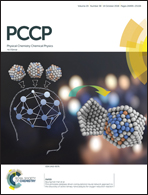High-symmetry tubular Ta@B183−, Ta2@B18, and Ta2@B27+ as embryos of α-boronanotubes with a transition-metal wire coordinated inside†
Abstract
Transition-metal doping leads to dramatic structural changes and results in novel bonding patterns in small boron clusters. Based on the experimentally derived mono-ring planar C9v Ta©B92− (1) and extensive first-principles theory calculations, we present herein the possibility of high-symmetry double-ring tubular D9d Ta@B183− (2) and C9v Ta2@B18 (3) and triple-ring tubular D9h Ta2@B27+ (4), which may serve as embryos of single-walled metalloboronanotube α-Ta3@B48(3,0) (5) wrapped up from the recently observed most stable free-standing boron α-sheet on a Ag(111) substrate with a transition-metal wire (–Ta–Ta–) coordinated inside. Detailed bonding analyses indicate that, with an effective dz2–dz2 overlap on the Ta–Ta dimer along the C9 molecular axis, both Ta2@B18 (3) and Ta2@B27+ (4) follow the universal bonding pattern of σ + π double delocalization with each Ta center conforming to the 18-electron rule, providing tubular aromaticity to these Ta-doped boron complexes with magnetically induced ring currents. The IR, Raman, and UV-vis spectra of 3 and 4 are computationally simulated to facilitate their future experimental characterization.



 Please wait while we load your content...
Please wait while we load your content...